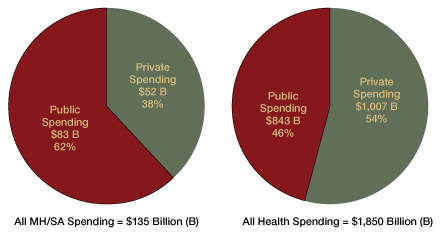Behavioral Health Spending Down
In 2005, behavioral health spending
accounted for 7.3 percent ($135 billion) of
the $1.85 trillion spent on all health care
services in the United States, according to
a recent SAMHSA report.
Spending on psychiatric drugs grew
by 5.6 percent from 2004 to 2005, down
from the 27.3 percent growth from 1999
to 2000.
Spending on addiction medications
is increasing but still remains relatively
small. As a result of the introduction of
new medications, spending on addiction
medications has grown rapidly—from $10
million in 1992 to $141 million in 2005.
The full report, National Expenditures
for Mental Health Services and Substance
Abuse Treatment, 1986–2005, analyzes
health care costs from 1986 to 2005 to
determine patterns in expenditures for
behavioral health services.
“For the first time, SAMHSA is
posting downloadable data files on these
findings: behavioral health spending by
major payers to major providers from
1986 to 2005,” said Rita Vandivort-Warren,
M.S.W., a senior public health analyst in
the Division of Services Improvement
at SAMHSA. “These data should help
researchers, policy analysts, and consumer
and advocacy groups to explore their
specific interests.”
During the 20-year study period,
both mental health and substance abuse
spending grew more slowly than all other
health spending: 4.8 percent annually for
substance abuse, 6.9 percent annually for
mental health, and 7.9 percent annually
for all health care services.
The same pattern held in the most
recent 2002 to 2005 period, in which
spending for substance abuse grew slowest
(5.0 percent), followed by mental health
(6.4 percent), and all health (7.3 percent).
The study found that private insurance
spends about 5 percent on behavioral
health treatment (mental health and
substance abuse). Spending on behavioral
health treatment comprised 4.8 percent
of private health insurance expenditures
in 2005 and grew by 7 percent from 2004
to 2005.
This estimate provides an important
baseline for future evaluations on the
impact of the Mental Health Parity and
Addiction Equity Act and the Affordable
Care Act.
In contrast, Medicaid behavioral
health was responsible for 11.5 percent
of total spending by Medicaid. Thus, the
study indicates that the level of public
spending on behavioral health issues may
be related to lack of private insurance and
that parity may address these problems.
Unlike overall health spending, the
majority of behavioral health services are
publicly funded.
In 2005, public payers accounted
for 79 percent of spending on substance
abuse treatment services and 58 percent
of spending on mental health services.
In contrast, public payers accounted for
less than half (46 percent) of all-health
spending.
Download the full report from SAMHSA’s website.
Enlarge image

In 2005, behavioral health spending accounted for 7.3 percent ($135 billion) of the
$1.85 trillion spent on all health care services in the United States. Of those total
amounts, the two pie charts above illustrate the percentages of public spending
versus private spending.
The full report, National Expenditures for Mental Health Services and Substance Abuse
Treatment, 1986–2005, is available on the SAMHSA Store.
Text only